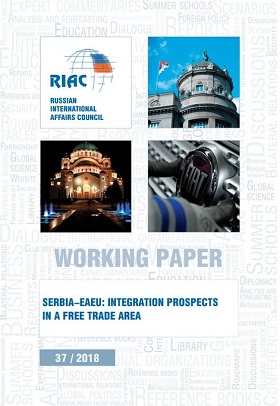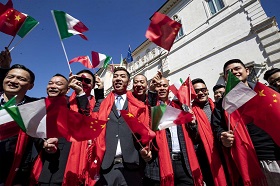Given the ongoing tensions between Russia and the European Union, only a few policy-makers and experts will give serious thought to the prospect of cooperation on connectivity between the EU, China, and Russia in Central Asia. However, as China further embarks on implementing its Belt and Road Initiative (BRI) and remains firmly set on pursuing the ambitious goal of connecting China overland with Europe, Russia and the EU — as indispensable stakeholders for this continental connection to successfully materialize — have been developing policy responses to China’s initiative that reveal an unexpected willingness to cooperate. The EU even recognizes this formally. In the EU’s new strategy for Central Asia, which has recently been released, connectivity is identified as one of the areas where possible synergies with other external partners should be established. However, it remains to be seen how such synergies will be achieved in concrete terms, especially with Russia.
At the practical level, it still remains to be seen which form cooperation between the EU and China in Central Asia will take. One option that may be possible in the short-term is cooperation in the form of ‘blending,’ whereby the EU may provide a grant to complement a loan extended by the European Bank for Reconstruction and Development (EBRD), which may then be topped up by a loan from the China-dominated AIIB. The EBRD is already co-financing loans with the AIIB for projects in Central Asia. Since the EU often cooperates with the EBRD in Central Asia and considers the AIIB as a reliable partner that follows international norms, it is only a small step before this type of joint financing schemes could materialize.
In the longer term, direct cooperation between the EU and China’s development banks, such as the China Development Bank and the Silk Road Fund, may also be possible. This is now already happening in Europe under the China-EU Co-investment Fund Programme, which was established by the European Investment Fund and Silk Road Fund to develop synergies between the BRI and the Juncker Plan. In the mid-term, such direct cooperation between the EU and China’s development banks may become possible in Central Asia. However, this will only be upon the difficult conditions that China will address the EU’s strong concerns over the debt trap that comes with China’s involvement in Central Asia and that for any projects implemented jointly China will abide by market-based principles and international norms of sustainability, openness, and transparency.
Given the ongoing tensions between Russia and the European Union, only a few policy-makers and experts will give serious thought to the prospect of cooperation on connectivity between the EU, China, and Russia in Central Asia. However, as China further embarks on implementing its Belt and Road Initiative (BRI) and remains firmly set on pursuing the ambitious goal of connecting China overland with Europe, Russia and the EU — as indispensable stakeholders for this continental connection to successfully materialize — have been developing policy responses to China’s initiative that reveal an unexpected willingness to cooperate. The EU even recognizes this formally. In the EU’s new strategy for Central Asia, which has recently been released, connectivity is identified as one of the areas where possible synergies with other external partners should be established. However, it remains to be seen how such synergies will be achieved in concrete terms, especially with Russia.
Converging interests
Although cooperation between Russia and the EU and on connectivity in Central Asia seems practically impossible in the short term due to the ongoing tensions over Ukraine, there does appear to be scope for cooperation, however tentative it may be. One thing is clear, China, Russia, and the EU have a common interest in advancing connectivity along the transport corridor between China and Europe that passes through Russia, and which is part of the Silk Road Economic Belt of the BRI. This land corridor is known as the New Eurasian Land Bridge and passes through Central Asia, namely Kazakhstan.
Substantial investments have already been made by China to make this land bridge a reality. Part of the first leg is already completed, namely the rail line that connects China with Kazakhstan through the border crossing at Khorgos. China, the EU, and Russia are increasingly aware that they need each other’s support and involvement if this Eurasian transport corridor is to be successfully completed.
There is one more land corridor between China and Europe under the Silk Road Economic Belt that passes through Central Asia, the China-Central Asia corridor. This one, however, bypasses Russia. Also, China has already been heavily investing in the construction of this corridor.
EU-Russia cooperation: science fiction?
As diplomatic relations between the EU and Russia remain at an all-time low, the idea of possible cooperation on connectivity between the two parties in Central Asia may seem more appropriate for a science fiction novel rather than for actual diplomatic discussions. Nevertheless, there is scope for cooperation. Both the EU and Russia were left with no choice but to respond to China’s ambitious BRI. The EU and Russia share an interest in finding synergies with the BRI as a way to balance China’s fast-growing clout in Eurasia. This is now very tentatively pushing both actors towards each other when it comes to Central Asia and is opening up possibilities for cooperation on connectivity. Although formally the EU is reluctant for the time being to enter into closer cooperation with Russia, informally the EU maintains a dialogue with Russia over Central Asia.
Russia from its side remains very keen on establishing formal engagement between the EU and the Eurasian Economic Union (EAEU). This would feed into Russia’s conception of the Greater Eurasian Partnership. However, the EU for the timing being is not willing to formally align itself with the EAEU. This is not only because of the conflict in Ukraine but also because the EU has several concerns about the incomplete nature of the EAEU as a customs and economic union.
Sino-Russian cooperation: a rhetorical reality
Cooperation on connectivity in Central Asia may seem more likely when it comes to Russia and China. Many experts argue that the tensions between the West and Russia over Crimea and the conflict in Ukraine have pushed Russia towards the East, including towards China. Russia and China have already formally aligned themselves by linking up the EAEU to the BRI. For Russia, the alignment of the BRI with the EAEU fits within the so-called Greater Eurasian Partnership that Russia aspires to create and which includes the BRI as part of a network of integration initiatives that together would form a transcontinental economic cooperation space stretching from Europe to Asia.
However, in terms of practical implementation of the alignment and cooperation on the ground, progress remains limited. This limited progress seems to suggest that the alignment is mostly rhetorical. Also, outside of the EAEU framework, progress on implementing the political commitment to cooperate seems very limited. This is to a large extent because Russia lacks the financial means to invest in large infrastructure projects. Given that there has been hardly any progress on joint implementation by China and Russia of infrastructure projects in Russia itself, it remains unlikely that Russia will be able to co-finance projects with China in Central Asia.
Concrete cooperation on connectivity between Russia and China seems most feasible in the framework of multilateral institutions, such as the Shanghai Cooperation Organization, and through co-financing of projects financed by development banks, such as the New Development Bank (NDB), Eurasian Development Bank (EDB) and Asian Infrastructure Investment Bank (AIIB). However, also in this regard, progress has been very limited. Memorandums of Understanding are being signed between all these banks, but concrete projects are not yet being implemented.
If such co-financed infrastructure projects materialize in Central Asia, then Russia is very likely to prioritize projects that are part of the Eurasian Land Bridge, as this corridor transits through Russia. Projects that are part of the China-Central Asia corridor, which circumvents Russia, are less likely to receive Russia’s support.
Sino-European cooperation: only a matter of time?
When it comes to possible cooperation on connectivity between the EU and China in Central Asia, there seems to be a much stronger basis. Both sides have already repeatedly mentioned that they want to establish synergies between them to jointly advance connectivity in Central Asia. So far, there has not been any cooperation between them on the ground in Central Asia, but there are several signs that it might only be a matter of time before this will happen.
A first concrete sign that the EU and China may cooperate on connectivity in Central Asia has come from the EU-China Connectivity Platform, which was established in 2015. The overall goal of the Platform is to strengthen synergies between the BRI and the EU’s connectivity initiatives. One of the specific objectives of the Platform is to support the implementation of infrastructure development in the relevant countries and regions situated along the corridors between China and Europe.
There has already been concrete progress in this regard. A long list of pilot projects has been established, and an expert group consisting of representatives of the European Investment Bank, European Bank for Reconstruction and Development (EBRD) and China Development Bank (CDB) has been created to work on the financing arrangements for these pilot projects. While the focus has so far been on infrastructure development in European countries and China, Central Asia has come up as another region where this cooperation may materialize. This is now also formally recognized in the new EU Strategy for Central Asia.
Initially, there were strong concerns that cooperation would be difficult to achieve due to the EU’s and China’s diverging understanding of connectivity, and of development more generally, which, moreover, they pursue by means of entirely different methods. When it comes to development cooperation, the EU prioritizes inclusive and sustainable development. The EU believes that development can only be durable if it accompanied with enhancements in governance. In contrast, China focuses mostly on enabling economic growth through the improvement of infrastructure. Unlike the EU, it does not seek to directly improve governance issues, because it adheres to the principle of non-interference and the primacy of the national sovereignty of states.
Today, it seems that both sides are increasingly finding a common language by linking their cooperation commitment to the Sustainable Development Goals (SDGs) of the UN’s 2030 agenda. This creates the impression that China is slowly converging towards the understanding that the EU has of connectivity and of international development. For instance, China no longer wants to focus solely on economic development, but it is now also ready to implement projects that are aimed at boosting social development and environmental protection.
Under the framework of the Connectivity Platform, the EU and China have agreed that projects implemented under this framework will abide by market-based principles and international norms and that they will promote openness, transparency and a level playing field in the projects that they will implement jointly. This point is a crucial condition for the EU to agree to cooperate with China on connectivity, as is clearly outlined in the EU's Connectivity strategy, which was presented in September 2018.
At the practical level, it still remains to be seen which form cooperation between the EU and China in Central Asia will take. One option that may be possible in the short-term is cooperation in the form of ‘blending,’ whereby the EU may provide a grant to complement a loan extended by the European Bank for Reconstruction and Development (EBRD), which may then be topped up by a loan from the China-dominated AIIB. The EBRD is already co-financing loans with the AIIB for projects in Central Asia. Since the EU often cooperates with the EBRD in Central Asia and considers the AIIB as a reliable partner that follows international norms, it is only a small step before this type of joint financing schemes could materialize.
In the longer term, direct cooperation between the EU and China’s development banks, such as the China Development Bank and the Silk Road Fund, may also be possible. This is now already happening in Europe under the China-EU Co-investment Fund Programme, which was established by the European Investment Fund and Silk Road Fund to develop synergies between the BRI and the Juncker Plan. In the mid-term, such direct cooperation between the EU and China’s development banks may become possible in Central Asia. However, this will only be upon the difficult conditions that China will address the EU’s strong concerns over the debt trap that comes with China’s involvement in Central Asia and that for any projects implemented jointly China will abide by market-based principles and international norms of sustainability, openness, and transparency.








